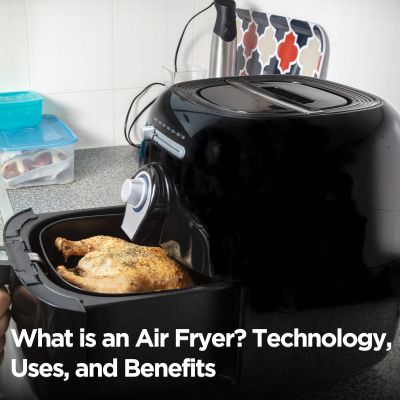More people are looking for ways to cook healthier meals without giving up the crispy texture of their favorite fried foods.
Deep frying has long been a go-to method for achieving golden, crunchy results, but it has a major drawback — excessive oil. High-fat cooking methods lead to weight gain and health risks like heart disease, leading many to search for a better alternative.
Air fryers are popular because they can produce crispy, golden-brown foods using little to no oil. They work by circulating hot air rapidly around the food, creating a texture similar to frying without the need for submersion in oil.
This means you can still enjoy crispy French fries, chicken wings, and baked goods with fewer calories and less fat.
In addition to health benefits, air fryers offer speed and convenience, making them a great addition to modern kitchens. But what exactly makes them different from traditional cooking methods? Let’s get into the technology behind air frying!
What is an Air Fryer?
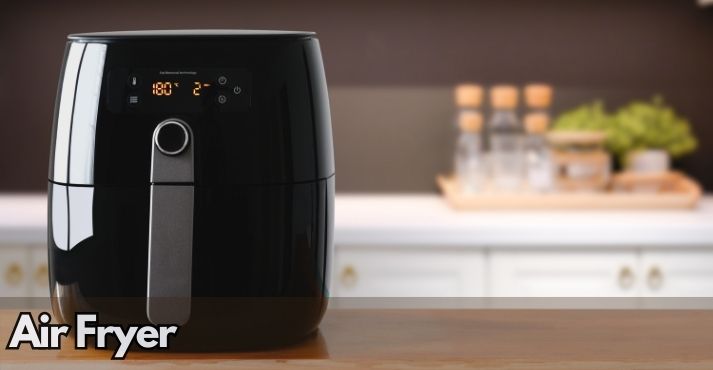
An air fryer is a compact countertop appliance that cooks food by rapidly circulating hot air, producing a crispy texture similar to deep frying but with significantly less oil.
This innovative approach to frying has gained widespread popularity, with the air fryer market projected to generate $7.12 billion in revenue in 2025.
The secret behind an air fryer’s efficiency is its convection mechanism. A high-powered fan distributes hot air evenly around the food, ensuring thorough cooking while creating a golden, crispy exterior.
Unlike traditional deep frying, which submerges food in oil, air frying requires only a light coating or no oil.
Initially developed as part of food service technology, air fryers have transitioned from commercial kitchens to home use, becoming a go-to appliance for health-conscious consumers and busy households.
Their ability to cook a wide range of foods like fries, chicken, vegetables, and even baked goods quickly and with minimal effort makes them an essential part in modern cooking.
How Does an Air Fryer Work?
Air fryers use rapid air technology to cook food quickly and evenly, creating a crispy exterior without the need for excessive oil.
Unlike traditional frying, which relies on hot oil immersion, air fryers use a powerful fan to circulate hot air around the food, mimicking the effect of deep frying but in a much healthier way.
Most air fryers operate at temperatures ranging from 180°F to 400°F, allowing them to cook various foods efficiently.
The high-speed air circulation reduces cooking times significantly compared to conventional ovens, making air fryers a time-saving alternative for busy households.
Foods that typically take 30-40 minutes in a standard oven can often be cooked in 15-20 minutes in an air fryer.
Because air fryers require little to no oil, they provide a healthier alternative to deep frying while still delivering the crispiness and texture people love.
This feature has made them a staple in home kitchens and a reliable option in commercial kitchen settings, where efficiency and consistency are essential.
Uses of an Air Fryer
Air fryers are incredibly versatile, making them valuable to any kitchen. Whether you want to bake, roast, grill, or fry, these appliances can easily handle various cooking methods.
Their ability to prepare various dishes has contributed to their growing popularity. With different types of air fryers available, such as basket-style, oven-style, and paddle-type, users can choose a model that best fits their needs.
Cooking Methods
Unlike traditional fryers, air fryers are multifunctional appliances that can perform several cooking techniques:
- Frying – Delivers crispy, golden-brown textures with minimal oil.
- Roasting – Perfect for meats, vegetables, and even nuts, giving them a rich flavor.
- Baking – Can be used for cakes, cookies, and muffins.
- Grilling – Achieves a slightly charred, smoky effect on meats and vegetables.
This adaptability makes air fryers convenient, delivering restaurant-quality results at home.
Types of Foods
Air fryers are not limited to just fries and chicken nuggets. They can cook a wide range of foods, including:
- Vegetables: Brussels sprouts, zucchini, bell peppers, and sweet potatoes roast beautifully.
- Meats: Chicken wings, steak, fish, and even pork chops cook evenly with a crispy finish.
- Frozen foods: Fries, mozzarella sticks, and fish sticks cook faster than in an oven.
- Desserts: Doughnuts, brownies, and churros can be air-fried for a lighter version of classic treats.
Recipe Ideas
For those looking for inspiration, here are some delicious dishes that can be made using an air fryer:
- Crispy Parmesan Brussels Sprouts – A healthy, flavorful side dish with a crunchy texture.
- Air-Fried Chicken Tenders – Juicy on the inside, crispy on the outside, and made with less oil.
- Garlic Butter Salmon – A quick and nutritious meal with a perfectly flaky texture.
- Homemade Sweet Potato Chips – A healthier alternative to store-bought chips.
- Air-Fried Apple Hand Pies – A warm, crispy dessert with a golden, flaky crust.
Whether preparing quick weeknight meals or experimenting with new dishes, air fryers offer endless possibilities. Their efficiency and ability to cook healthier versions of favorite foods make them a must-have in any kitchen.
Benefits of Using an Air Fryer
Incorporating an air fryer into daily cooking offers several advantages, from health benefits to convenience and safety. With its ability to cook food quickly, reduce oil usage, and improve kitchen safety, an air fryer is an excellent addition to any kitchen.
Health Benefits
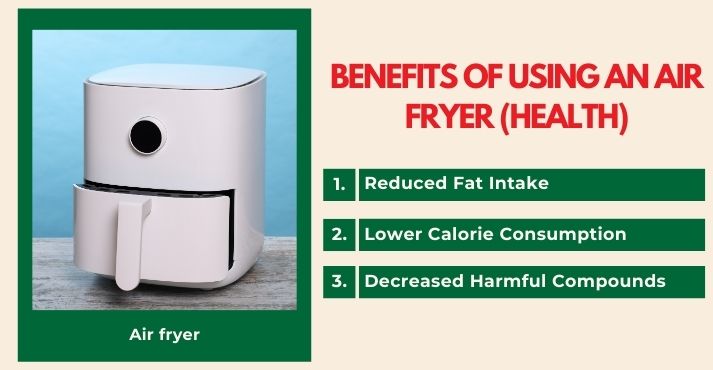
Air frying provides a healthier alternative to traditional deep-frying by cutting down on excess fat and harmful compounds while preserving the flavor and texture of food.
1. Reduced Fat Intake
Air fryers can lower fat content by up to 75% compared to deep-frying. Instead of submerging food in oil, air fryers use hot air circulation to create a crispy texture with minimal or no added oil.
This makes them ideal for preparing traditionally fried foods like French fries, chicken wings, and onion rings while significantly reducing unhealthy fats.
Air frying is a beneficial alternative for individuals who manage cholesterol levels or reduce saturated fat intake.
2. Lower Calorie Consumption
By requiring little to no oil, air fryers help reduce overall caloric intake, making them a useful appliance for those focused on weight management and healthier eating habits.
Since each tablespoon adds about 120 calories, eliminating or reducing oil usage can lead to substantial calorie savings over time.
This makes air frying a preferred cooking method for those following low-calorie diets or aiming to maintain a balanced lifestyle without sacrificing the taste and texture of fried foods.
3. Decreased Formation of Harmful Compounds
Deep-frying at high temperatures can produce acrylamide, a potentially harmful compound linked to certain health risks. Studies show that air-fried foods contain up to 90% less acrylamide than deep-fried alternatives.
This is important when cooking starchy foods like potatoes, which are more prone to acrylamide formation. Using an air fryer allows individuals to enjoy crispy foods with fewer carcinogenic risks, making it a safer choice for long-term health.
Convenience
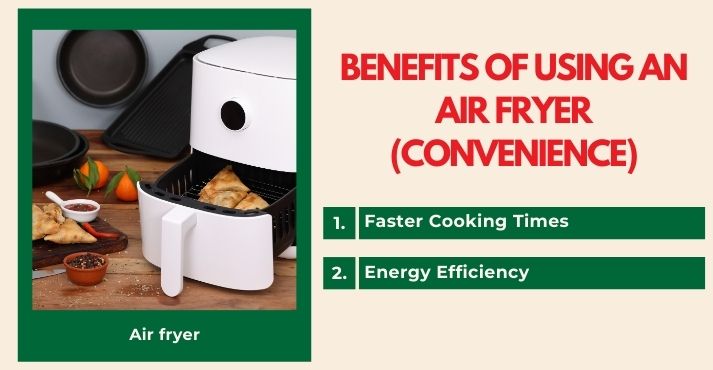
Air fryers simplify cooking by reducing meal prep time and energy consumption, making them a practical option for busy households and professional kitchens.
1. Faster Cooking Times
Air fryers heat up quickly and cook food faster than traditional ovens. For example, foods that take 30-40 minutes in an oven can often be prepared in half the time in an air fryer.
The rapid air technology ensures even heat distribution, allowing food to cook efficiently without flipping or constant monitoring.
Whether preparing frozen foods, reheating leftovers, or cooking fresh ingredients, an air fryer helps reduce wait times while maintaining the best texture and flavor.
2. Energy Efficiency
Because air fryers are compact and cook food rapidly, they use less energy than conventional ovens, making them a more efficient choice for daily cooking.
The smaller cooking chamber requires less preheating time and maintains heat better, reducing electricity consumption. This energy efficiency benefits homeowners looking to lower utility bills and commercial kitchens seeking cost-effective cooking solutions.
Safety
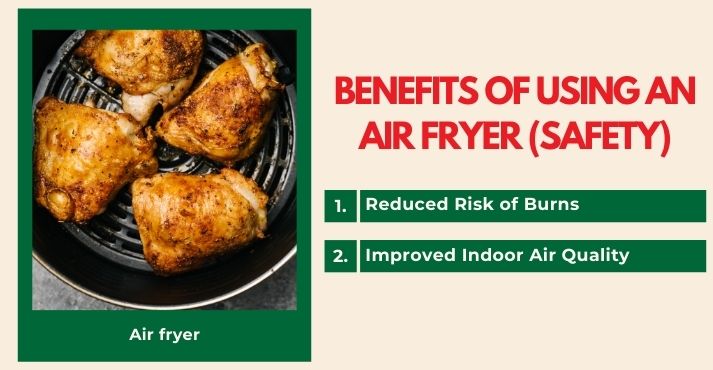
In addition to being healthier and more convenient, air fryers enhance kitchen safety by reducing the risk of burns and improving air quality.
1. Reduced Risk of Burns
Traditional deep-frying involves handling hot oil, which increases the likelihood of burns and grease fires. Air fryers eliminate these risks by using enclosed cooking chambers with minimal oil.
Many models also feature automatic shut-off functions and cool-touch exteriors, reducing the chances of accidental burns. This makes air fryers safer for homes with children and busy environments where safety and efficiency are crucial.
2. Improved Indoor Air Quality
Unlike deep-frying, which releases oil fumes and airborne grease particles, air fryers produce fewer volatile organic compounds (VOCs), leading to cleaner indoor air and a safer cooking environment.
This benefits those with respiratory conditions or allergies, as it helps minimize exposure to harmful fumes and lingering food odors.
Additionally, air fryers reduce the need for excessive ventilation, making them a great choice for compact kitchens or apartments where maintaining air quality is essential.
Potential Drawbacks of Using an Air Fryer
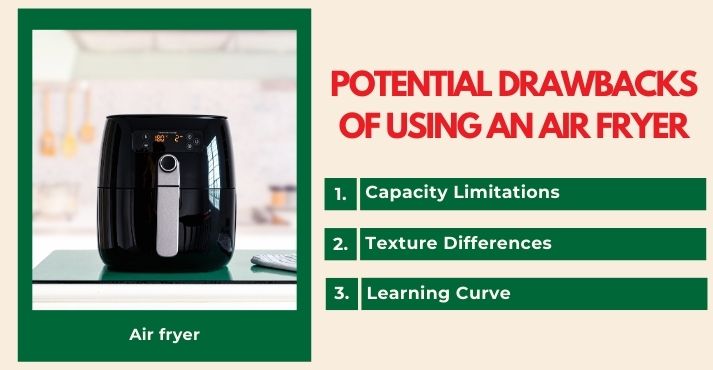
While air fryers offer numerous benefits, they are not without limitations. Understanding the air fryer’s pros and cons can help consumers make informed decisions before purchasing one.
1. Capacity Limitations
Most air fryers are compact appliances, making them ideal for small households or individuals but less suitable for large families or bulk cooking.
Standard models typically accommodate 2 to 6 quarts, so cooking large portions requires multiple batches. This can be inconvenient for those preparing meals for many people or working in food service operations where high-volume cooking is necessary.
Some larger models exist but take up more counter space, which may be challenging for smaller kitchens.
2. Texture Differences
Although air fryers are designed to replicate the crispiness of deep-fried foods, the texture is not always identical. Traditional deep-frying submerges food in hot oil, creating a distinct crunch and juiciness.
On the other hand, air-fried foods rely on hot air circulation, which may result in a slightly drier texture.
While some foods, like fries and chicken wings, can come out crispy, others might lack the same richness and moisture that deep-frying provides. A light oil spray can help improve texture but may not fully replicate the deep-frying experience.
3. Learning Curve
New air fryer users often need time to adjust to the appliance’s cooking times and temperature settings. Unlike conventional ovens or stovetop cooking, air fryers operate differently, meaning recipes may require trial and error to perfect.
Certain foods may need shaking or flipping midway through cooking to ensure even crispiness. Additionally, because air fryers cook faster than ovens, overcooking or drying out food is a common mistake for beginners.
Fortunately, users can quickly learn how to maximize their air fryer’s potential with practice and experimentation.
Best Practices for Using an Air Fryer
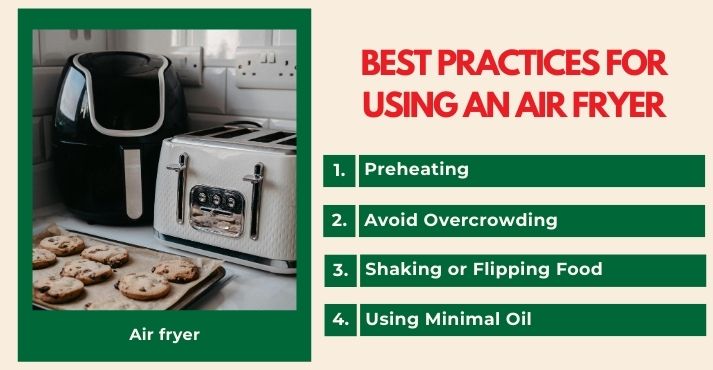
Following a few best practices is essential to get the best results from an air fryer and extend its lifespan. These tips help ensure even cooking, better texture, and long-term appliance performance.
1. Preheating
Like an oven, preheating an air fryer helps achieve consistent cooking results. Most models only take 2-5 minutes to reach the desired temperature, ensuring food starts cooking immediately upon placement.
This step enhances crispiness and helps maintain even heat distribution, preventing undercooked spots. Some air fryers have an automatic preheat function, while others require manually setting the temperature before adding food.
2. Avoid Overcrowding
For the best results, it’s important not to overcrowd the basket. Overloading food in a single layer restricts airflow, leading to uneven cooking and soggy textures.
Instead, arrange food in a single layer and cook in batches if necessary. If using an air fryer with multiple racks, rotating them halfway through can help ensure all items cook evenly.
3. Shaking or Flipping Food
To ensure even crispiness, it’s recommended to shake the basket or flip food halfway through the cooking process. This technique benefits fries, nuggets, and small vegetables, allowing all sides to crisp up evenly.
Some modern air fryers have an automatic stirring function, but manually shaking the basket every 5-7 minutes can significantly improve results for those who don’t.
4. Using Minimal Oil
While air fryers require little to no oil, a light spray or brush of oil can enhance the crispiness of certain foods, such as fries or breaded items. However, too much oil can lead to excess smoke or greasy textures.
Opt for high-smoke-point oils like avocado, canola, or olive oil, and avoid aerosol cooking sprays that may damage the air fryer’s nonstick coating.
Maintenance and Cleaning of an Air Fryer
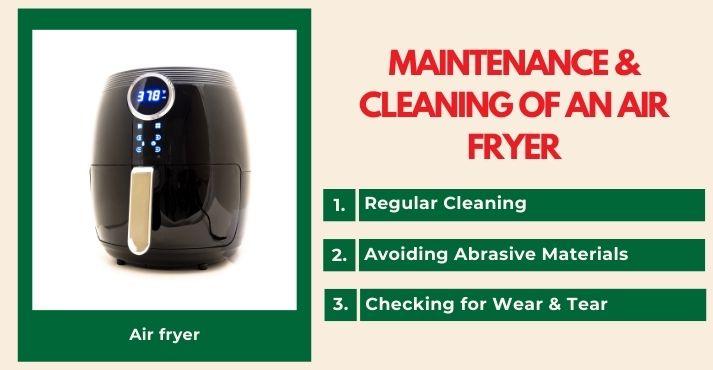
Proper maintenance and regular cleaning can extend the lifespan of an air fryer and ensure it functions efficiently. A few simple steps can prevent residue buildup, protect nonstick surfaces, and keep the appliance in top condition.
Industry events like the Food Service Expo often showcase best practices for maintaining kitchen equipment, emphasizing the importance of regular care for long-term performance.
1. Regular Cleaning
Cleaning the basket, tray, and pan after each use is crucial to maintain performance. Leftover grease and food particles can accumulate, leading to smoke, unpleasant odors, and potential mechanical issues.
After the appliance cools down, remove the components and wash them with warm, soapy water. Most air fryer accessories are dishwasher safe, but always check the manufacturer’s instructions.
2. Avoiding Abrasive Materials
Since most air fryers have a nonstick-coated basket and tray, harsh scrubbers or abrasive cleaners can damage the surface over time. Instead, opt for soft sponges, microfiber cloths, or silicone brushes to remove stuck-on food.
If grease is stubborn, soaking the basket in warm water for a few minutes can help loosen debris without scrubbing.
3. Checking for Wear and Tear
Regularly inspect the air fryer for any signs of damage, such as peeling, nonstick coating, loose parts, or electrical cord wear. If the nonstick coating begins to deteriorate, replacing the basket may be necessary to prevent flaking into food.
Additionally, ensure the air vents are unobstructed, as clogged vents can affect airflow and cooking efficiency.
Conclusion
With the rise of healthier eating habits, air fryers have become a go-to kitchen appliance for many households.
Their ability to cook food with little to no oil while achieving a crispy texture makes them a practical alternative to deep-frying. Plus, they’re versatile—perfect for everything from roasting vegetables to making desserts.
Of course, air fryers aren’t without their limitations. The smaller capacity can be a challenge for larger families, and the texture of certain foods may differ slightly from traditional frying.
However, with some experimentation, users can adapt recipes and cooking techniques for the best results.
An air fryer is a worthwhile investment for those looking to cut back on oil, reduce cooking time, and simplify meal prep. This appliance can be a reliable option for creating delicious and healthier daily meals by following proper usage and maintenance tips.

